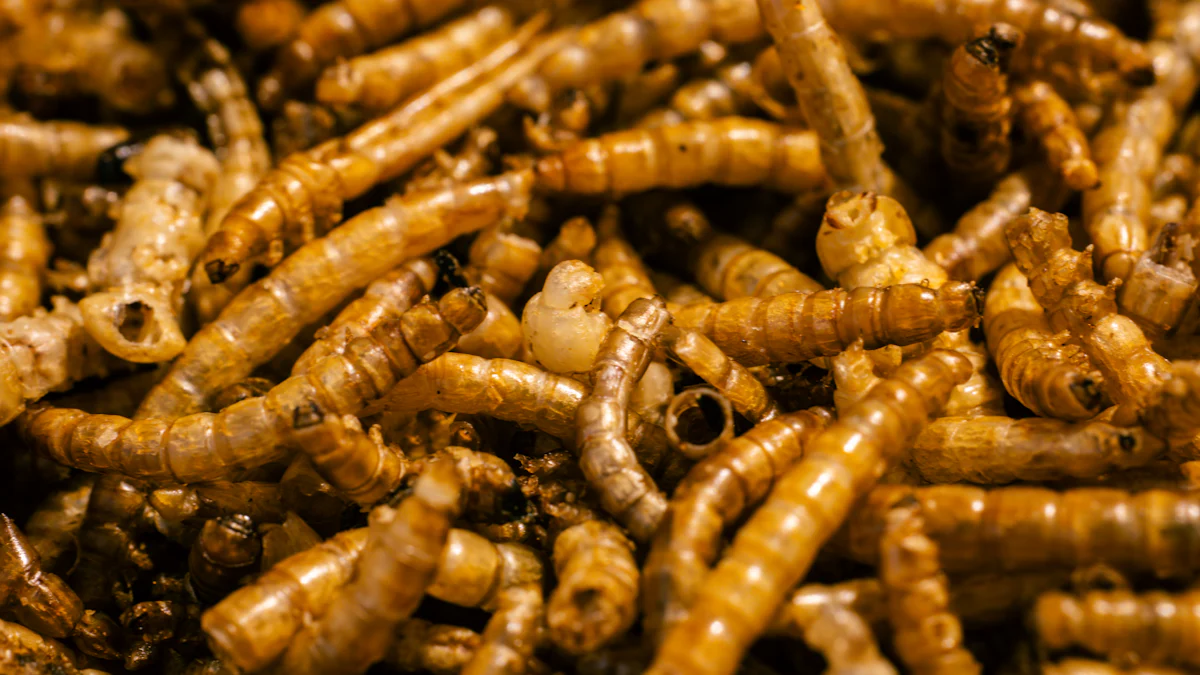
Have you ever thought about how much water and land go into producing your favorite snacks? It’s staggering! That’s why I’m excited about dried mealworms. These tiny powerhouses require minimal resources to farm. They even thrive on organic waste, turning scraps into protein. Plus, they emit far fewer greenhouse gases than cows or pigs.
Key Takeaways
- Dried mealworms are full of protein, with 14-16 grams in a 28-gram serving. They have all nine important amino acids, making them a good replacement for regular meats.
- Farming mealworms uses much less water and land than raising animals. They can live on organic waste, which makes them an eco-friendly food option.
- You can eat dried mealworms by mixing them into salads, soups, or smoothies. They add nutrients and a crunchy feel, making healthy snacks tasty and simple.
Nutritional Benefits of Dried Mealworms
When I first heard about dried mealworms, I was curious about their nutritional value. Let me tell you, they pack a punch! These little critters are a powerhouse of protein, which is great for anyone focused on health and fitness. In fact, dried mealworms contain between 48% to 54% protein. That’s more than chicken or beef! A typical serving of 28 grams gives you about 14-16 grams of high-quality protein. Plus, they have all nine essential amino acids, making them a fantastic alternative to traditional animal proteins.
But that’s not all. Dried mealworms are rich in essential fatty acids and nutrients. They contain unsaturated fats, including omega-3 and omega-6, which are crucial for heart health. Here’s a quick look at what you get in a 28-gram serving:
| Nutrient | Amount per 28g Serving | Benefits for Human Health |
|---|---|---|
| Protein | 14-16 grams | High-quality protein containing all essential amino acids. |
| Unsaturated Fats | 30-40% | Includes omega-3 and omega-6 fatty acids for heart health. |
| B Vitamins | Various | Vital for energy metabolism and red blood cell production. |
| Iron | Noteworthy | Contributes to daily iron requirements, preventing anemia. |
| Calcium, Zinc, Magnesium | Present | Important minerals for overall health. |
Now, let’s talk about energy. Dried mealworms are low in carbohydrates, with about 10% content, mostly as chitin, which acts as dietary fiber. This low-carb profile, combined with their high protein and healthy fats, makes them a high-energy food. The presence of essential unsaturated fats further boosts their energy density. So, if you’re looking for a snack that fuels your body, dried mealworms might just be the answer.
Environmental Sustainability of Dried Mealworms
Minimal Resource Requirements
When I first learned about how little it takes to produce dried mealworms, I was amazed. These tiny insects are incredibly efficient. For every pound of mealworms, only about 2 pounds of food are needed. Compare that to cows, which require 8 pounds of feed for just 1 pound of meat. That’s a huge difference! Mealworms also need far less water—less than half a gallon per pound. To put it into perspective, soy farming uses 500 times more water than mealworm farming.
Another thing I love is how mealworms can thrive on organic waste. They turn scraps into protein, making them a sustainable option. Plus, they can be farmed vertically, which means they take up much less space than traditional livestock. In fact, mealworms are at least 17 times more productive per unit of space than soy. This makes them a fantastic choice for areas with limited land or resources.
Reduced Greenhouse Gas Emissions
Did you know that mealworms produce far fewer greenhouse gases than traditional livestock? I was shocked to learn that mealworm farming emits 23% less greenhouse gas compared to broiler chicken production. It also uses 18% less non-renewable energy and occupies 70% less agricultural land. That’s a win for the planet!
Mealworms also cause 72% less terrestrial acidification than broilers. This means they have a much smaller impact on soil health. With such a low environmental footprint, it’s clear that mealworms are a sustainable protein source.
Contribution to Global Food Security
I believe mealworms could play a big role in solving global food challenges. They’re easy to farm, require minimal resources, and provide high-quality protein. In regions where land and water are scarce, mealworms offer a practical solution. Their ability to consume waste streams also makes them a smart choice for sustainable food systems.
Mealworms (Tenebrio molitor) have great potential to serve as a sustainable food source for humans. Their nutrient profile and low environmental impact make them ideal for feeding a growing population. By optimizing feed formulations, we can further improve mealworm production and help meet global food demands.
Incorporating Dried Mealworms into Your Diet
Enjoy Them as a Snack
When I first tried dried mealworms, I was surprised by how versatile they are as a snack. They’re crunchy, nutty, and packed with protein. If you’re looking for quick ways to enjoy them, here are some ideas:
- Sprinkle them on top of your salad for an extra crunch.
- Add them to soups as a topping for texture and flavor.
- Blend them into smoothies for a protein boost.
- Bake them into protein bars or cookies for a nutritious treat.
Dried mealworms are rich in protein, healthy fats, and essential vitamins, making them a great choice for snacking. With about 50-60% protein content, they’re perfect for anyone who wants a healthy, energy-packed snack.
Use Them in Recipes for Added Protein
I’ve also started experimenting with dried mealworms in recipes, and they’re a game-changer. One of my favorites is a Mealworm Lentil Salad. It combines lentils, cherry tomatoes, and roasted mealworms for a protein-rich dish that’s both delicious and filling. You can also try adding them to baked goods like muffins or bread. They enhance the nutritional profile and add a unique texture.
If you’re into smoothies, toss a handful of dried mealworms into your blender. They mix well with fruits and greens, giving your drink an extra protein kick. Whether you’re cooking or baking, these little insects are a fantastic way to boost your meals.
Growing Popularity of Insect-Based Foods
Did you know that over two billion people worldwide already eat insects? That blew my mind! This growing trend shows how people are shifting toward sustainable eating practices. Dried mealworms, in particular, are gaining attention because of their low environmental impact and high nutritional value.
As more people learn about the benefits of insect-based foods, I think we’ll see them popping up in more stores and recipes. They’re not just a novelty—they’re a practical, eco-friendly solution for feeding a growing population. Mealworms (Tenebrio molitor) have great potential as a sustainable food source due to their nutrient profile and minimal environmental footprint. By optimizing feed formulations, we can make mealworm farming even more efficient.
If you haven’t tried dried mealworms yet, now’s the time to jump on this trend. They’re not just good for you—they’re good for the planet too.
Addressing Concerns About Dried Mealworms
Safety and Nutritional Standards
When I first considered trying dried mealworms, I wanted to know if they were safe to eat. Thankfully, organizations like the European Food Safety Authority (EFSA) have done the research. They’ve determined that mealworms are safe for consumption as a novel food. Here’s a quick breakdown of the standards in place:
| Aspect | Details |
|---|---|
| Authority | European Food Safety Authority (EFSA) |
| Safety Determination | Mealworms are deemed safe for consumption as a novel food. |
| Forms Assessed | Whole, paste, and powder forms of frozen and freeze-dried mealworms were evaluated. |
| Nutritional Components | Main components include crude protein, fat, carbohydrates, and chitin fiber. |
| Toxicity Study | A 90-day toxicity study did not raise food safety concerns. |
| Allergen Warning | Potential allergic reactions for individuals with crustacean and dust mite allergies noted. |
| Pending Confirmation | EFSA assessment is pending confirmation by the EC’s Health Directorate General. |
Mealworms (Tenebrio molitor) have great potential as a sustainable food source. Their nutrient profile is impressive, with 50-60% protein, healthy unsaturated fats, and essential vitamins like B vitamins and iron. However, if you’re allergic to crustaceans or dust mites, you might want to consult a doctor before trying them.
Proper Storage and Handling
I’ve learned that proper storage is key to keeping dried mealworms fresh and safe. Here are some tips I follow:
- Freeze for Surplus: If I have extra mealworms, I freeze them at temperatures below -15°C in airtight containers. This keeps them fresh for over six months.
- Dry for Long-Term Storage: Drying mealworms or turning them into powder works well for long-term use.
- Check Quality on Arrival: When I buy mealworms, I always check their condition to ensure they’re free from contamination.
These simple steps help maintain the quality and safety of mealworms, making them a reliable snack or ingredient.
Overcoming Cultural Barriers
I get it—eating insects might feel strange at first. It’s not something many of us grew up with. But did you know that over two billion people worldwide already eat insects? That fact really opened my eyes.
I think the key to overcoming this barrier is education. Once I learned about the nutritional benefits and environmental advantages of mealworms, I felt more comfortable giving them a try. Plus, they’re so versatile! You can snack on them, add them to recipes, or even bake them into treats.
It’s all about changing perspectives. Mealworms aren’t just bugs—they’re a sustainable, nutritious food source with a low environmental impact. By embracing them, we can take a step toward a more sustainable future.
Dried mealworms are more than just a snack—they’re a step toward a sustainable future. They require less land, water, and resources than traditional livestock. Plus, they efficiently turn food waste into protein. Mealworms (Tenebrio molitor) have great potential as a sustainable food source, offering high nutrition with minimal environmental impact. Why not give them a try?
FAQ
What do dried mealworms taste like?
To me, they taste nutty and slightly earthy. Their flavor reminds me of sunflower seeds or roasted nuts. They’re mild, so they blend well with other foods.
Are dried mealworms safe to eat?
Yes, they’re safe! Mealworms (Tenebrio molitor) meet food safety standards. Just make sure you buy them from reputable sources and store them properly to maintain freshness.
How are mealworms sustainable compared to other protein sources?
Mealworms require fewer resources like water and land. They also emit less greenhouse gas. Plus, they turn organic waste into protein, making them an eco-friendly food option.


